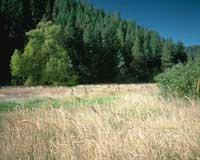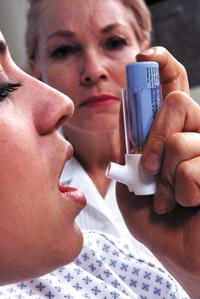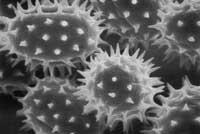Allergies: threat of spring
1999/05/01 Agirre, Jabier - Medikua eta OEEko kidea Iturria: Elhuyar aldizkaria
What are allergies?
Doctors love to say that “each patient is different from the others.” Well, allergies are the best proof of this statement. So, and to put an example, while the sting of a bee is only a small annoyance and irritation for some (fortunately for most of us), for others (and those we will call allergic) it can be a serious accident that cause serious risks and consequences for health.
According to Margarita Fernández, medical consultant of the Department of Allergology and Immunology of the University Clinic of Navarra, "allergy is understood as an excessive reaction of the body through an immune response to certain substances. These patients have a genetic predisposition to have allergy from birth, and in most cases those with allergic symptoms usually have a family history.
At birth, therefore, our genes carry implicit this information (the predisposition to suffer allergy), but this does not mean that we are necessarily allergic, but if we come into contact with certain substances (called allergens) this allergy will manifest. In the future, and thanks to advanced diagnostic methods, you will be able to know who will be allergic and doctors will try to remedy it before it happens with genetic therapy. But today, all you can do is wait for the symptoms to appear and then treat the disease (if possible).
Pollen, the greatest enemy
Spring allergies can be produced by different allergens. Plant pollen or parrot is the most common allergen that affects more people. It is followed by insect bites, especially bees and wasps, contact with certain plants or flowers and sun allergy, which fortunately is not common among us.

During spring, temperature increases, plants bloom and pollen or vases expand by the action of wind. In the previous months, the number of rainfall, if scarce, increases pollination rates considerably. The humid regions, which rain the most, are the most suitable for an allergic person, since rainwater prevents pollen from circulating in the air, in addition to helping "clean" the environment. On the contrary, regions such as Andalusia, Extremadura and the Central Plateau are dry territories where a high concentration of pollen accumulates, making them the regions less favoured for allergy sufferers.
Other types of spring allergy (insects, some flowers or plants, as well as heat or sun allergy) can be avoided with some ease, since if you have no contact or contact with the substance, it will never appear. However, efforts to avoid allergic reaction can radically change life, as is often the case for people allergic to the sun, or for people who, despite intense heat, are forced to keep the body covered.
In addition to genetic factors, environmental factors such as pollution or pollution, climate change and living habits also influence. For example, sensitization to the hairs of pets (cats or dogs) is becoming more frequent and manifests at all times of the year, since coexistence with these animals is increasingly close in our homes.
How does the allergy appear?
Not all allergy sufferers have allergic reactions the same way. Despite the same type of allergy and the same substance or allergen, each person reacts differently to external aggression, also written and determined in genes.
- Some will have rhinoconjunctivitis, known as "hay fever": olins or sneezing, runny nose, nasal itching, eye itching, watery eyes, swollen eyelids, and conjunctivitis. The main difference between allergic rhinitis and other types of rhinitis is that the first appears suddenly and that in a short time a lot of sneezing is done.
- In other cases bronchial symptoms predominate, bronchial asthma being the most frequent pathology. The immune component of the allergy causes inflammation of the bronchial mucosa and the contraction of the muscle fibers of the bronchial walls: difficulty breathing, drowning sensation and cough are the symptoms perceived by the person with allergic asthma.
- Finally, superficial symptoms such as so-called hives may appear. The fact that the skin is the part of the body affected by the allergy does not mean that the irritant necessarily has physical contact with the skin, as in the previous cases it can penetrate by inhalation. The typical sign of urticaria is an irregular, pale rash around which a red-intense circle forms. It appears throughout the body, but it is in the limbs where most appear. Hives cause a hard bite, but you don't need to press it to prevent the skin from getting irritated.
Instead of swelling in the skin, when inflammation occurs in the lower tissue, the disorder is called angioedema. It does not spread all over the body, usually has a single position, for example on the lips, eyelids, scophins or legs, and genital. Since allergic manifestations have disappeared in a few days and do not reappear until you contact the allergic person again, it can be very difficult to know the origin of the allergy.
If someone fears being allergic or is suspected that a disease that has had once or several times is allergy, it is best to go to a specialist to make a diagnosis of certainty and identify the substance that has produced the symptomatology.
What about treatment?
Treatment, of course, is to avoid the allergen if possible. And if this is not possible, in the case of pollen, for example, treatment is usually immunotherapy, that is, vaccines. With them it is intended to accustom the body to contact with the allergen, to achieve this, very small amounts of allergen are injected into these vaccines to gradually increase. The time necessary to perceive the benefits of treatment always depends on each person, so the treatment should be personalized.
Care measures to takeA) If you have allergic rhinitis: Close the windows of the house at night and bring the car windows always closed, with filters or air conditioning filters.
B) If you have allergic asthma: Do not smoke and avoid, if possible, charged environments. Ventilate the house well but not during the pollination hours indicated above. Air conditioning filters must be cleaned periodically. |

Gai honi buruzko eduki gehiago
Elhuyarrek garatutako teknologia





